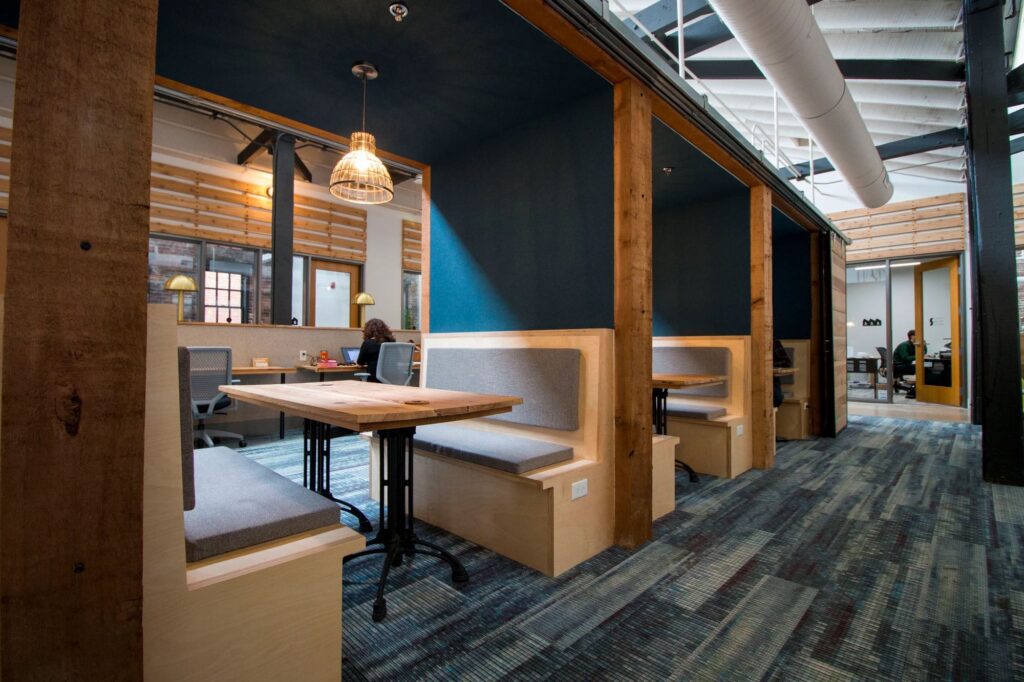In Bloomington, Indiana, a former factory that once symbolized American manufacturing is now the home of a new economic revolution. In the same space where wooden furniture was once produced in large numbers, entrepreneurs now gather to design the future of technology and business. However, rather than being a straightforward real estate change, this shift is a reaction to a more significant issue that American cities are currently confronting: the need to adapt to changes in the economic landscape. For most of the 20th century, Bloomington was a manufacturing center. Factories such as Showers Brothers, General Electric, and RCA have provided stable and well-paid jobs that have supported the local economy and the growth of the community, but as the 21st century began, the forces of globalization, automation, and technological disruption began to undermine the foundations on which Bloomington had built its prosperity.
The transformation of local economies in the wake of deindustrialization has been a pressing issue across the United States. Cities like Bloomington, once thriving on industries such as furniture manufacturing and television production, have seen these traditional sectors decline or disappear entirely. This has left behind economic voids that are challenging to fill, with job losses and stagnating wage growth being common consequences. The challenge is clear: how can these cities reinvent themselves in a rapidly changing economic landscape? The struggle to retain talent, attract investment, and foster innovation is no longer confined to the tech giants on the coasts. It’s a nationwide concern.
Enter Dimension Mill, or simply The Mill, a nonprofit innovation hub that has become the cornerstone of Bloomington’s economic revival. Pat East, the Executive Director of The Mill, is a man with a vision. East has demonstrated a thorough awareness of the potential and problems presented by this new era through his path from the realm of digital marketing to the leadership of one of Indiana’s most ambitious innovation incubators. “We’re trying to build a lot of assets and resources that not only our founders need, but that people who want to live in Bloomington or a similar city like ours would want,” says East. His goal is nothing short of turning Bloomington into the tech entrepreneurship capital of Indiana. The Mill is housed in a renovated 19th-century factory that once produced 60% of the United States’ furniture. The building’s transformation from an industrial relic into a state-of-the-art coworking and innovation space is symbolic of the broader economic shift occurring within Bloomington. “Now our job is to manufacture entrepreneurs to manufacture founders so that they can build whatever the next versions are,” East explains, highlighting the pivot from physical goods to intellectual capital.
The Mill’s strategy to address Bloomington’s economic challenges is multifaceted, focusing on cultivating a robust startup ecosystem that can generate high-paying jobs and attract new residents. Central to this strategy is the establishment of the Trades District, a 12-acre innovation hub in downtown Bloomington. The Mill is the anchor institution in this district, which is designed to be a breeding ground for tech startups and a magnet for talent. The hub is expected to create 866 new jobs and inject $218 million into the local economy over the next decade (WBIW). One of The Mill’s key initiatives is the Flywheel Fund, a micro-investment fund that has already invested $1.6 million in 29 Indiana-based startups (WBIW).
This seed funding has enabled these companies to attract an additional $8.9 million in outside investment, showcasing The Mill’s ability to catalyze economic growth. “We want more people who are building companies,” East asserts, underscoring The Mill’s focus on fostering a new generation of entrepreneurs. Moreover, The Mill’s comprehensive programming includes statewide pitch competitions, pre-accelerators, bootcamps, and a code school. These initiatives are designed to upskill and reskill the local workforce, making Bloomington not only a place to live but a place to thrive in a tech-driven world. The code school, for instance, is part of a broader effort to integrate more residents into the digital economy, addressing both employment and wage growth concerns.

The success of The Mill has not gone unnoticed. Bloomington has climbed the ranks to become one of the top startup cities in the Midwest, a remarkable achievement for a city of its size. TechPoint, Indiana’s nonprofit industry group for the tech sector, named Bloomington Indiana’s Rising Tech City in 2021, citing The Mill as a critical driver of this success (WBIW). As The Mill continues to expand its influence, it is also shaping the future of the tech industry in Indiana. The state’s broader strategy to become a tech powerhouse includes initiatives like the Silicon Crossroads Microelectronics Hub, which has secured $32.9 million in federal funding (Business Wire). This positions Indiana as a key player in the national tech landscape, with Bloomington and The Mill playing pivotal roles.
The industry itself is poised for significant growth, driven by the increasing importance of innovation hubs across the country. These hubs, such as the one in Bloomington, are becoming critical nodes in a national network of tech ecosystems. According to a report by the U.S. Economic Development Administration, such hubs are essential for maintaining the country’s economic and national security by ensuring that industries and the jobs they create remain in the United States (U.S. Economic Development Administration).
Bloomington’s success story could serve as a model for other small and mid-sized cities looking to reinvent themselves. The intentional clustering of tech companies and the strategic public-private partnerships that The Mill has fostered are key elements of this success. The collaboration between The Mill, the City of Bloomington, and Indiana University exemplifies how different sectors can work together to drive economic development. For example, the collaboration between The Mill and IU helped secure a $16 million grant to advance the Trades District in order to make it a key innovation hub in Bloomington and Indiana as a whole (WBIW). The Mill’s influence in Bloomington is evident, it is reshaping the city by filling the economic hole created by deindustrialization with a new emphasis on technology and innovation, while also laying the groundwork for other places to follow suit. The lessons learned from The Mill’s success could have far-reaching implications for cities across the United States.






